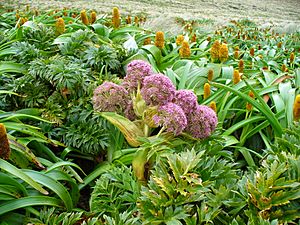Campbell Island carrot facts for kids
Quick facts for kids Campbell Island carrot |
|
|---|---|
 |
|
| Anisotome latifolia on Campbell Island, with Bulbinella rossii in the background | |
| Scientific classification | |
| Genus: |
Anisotome
|
| Species: |
latifolia
|
| Synonyms | |
|
|
The Anisotome latifolia, often called the Campbell Island carrot, is a type of flowering plant. It belongs to the plant family called Apiaceae.
Contents
What is the Campbell Island Carrot?
The Campbell Island carrot is a very large and strong perennial herb. This means it lives for more than two years and has soft, green stems instead of woody ones. It can grow up to 2 meters (about 6.5 feet) tall.
Its tough, leathery leaves grow from the base of the plant. They are usually 300–600 mm (12–24 inches) long and 100–200 mm (4–8 inches) wide. Each leaf has 5-7 pairs of dark to yellow-green smaller leaflets.
The main flower stalk can also reach up to 2 meters tall. Its flowers can be off-white or a creamy pink color. This plant flowers from October to February. It then produces fruits from January to March.
Where Does it Grow?
The Campbell Island carrot is endemic to New Zealand. This means it naturally grows only in a specific place. You can find it on New Zealand’s subantarctic Auckland and Campbell Islands.
It is a very important part of the "megaherb" community there. Megaherbs are unusually large herbaceous plants. This plant grows from the coast all the way up to the tops of the island ranges. It likes peaty ground, which is soil made of decayed plant matter. You can often see it among tall grasses called tussocks and other megaherbs. It is less common in areas with low forests.
The plant grows best at lower altitudes. It also thrives where animals do not eat it too much. Some introduced animals can eat these plants. This makes it harder for them to grow in those areas.

How to Grow Campbell Island Carrots
It is quite easy to grow the Campbell Island carrot from fresh seeds. You need deep, peaty soil that stays moist all the time. However, this plant does not like hot weather. So, it grows best in cooler climates.
See also
 In Spanish: Anisotome latifolia para niños
In Spanish: Anisotome latifolia para niños

